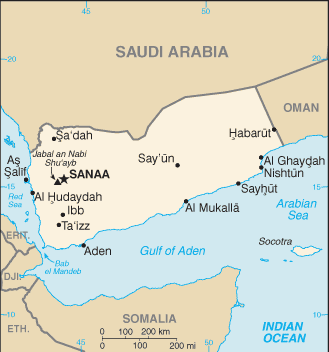Why Are Yemen’s Houthis Attacking U.S. Ships?
Why Are Yemen’s Houthis Attacking U.S. Ships?
The History of American Intervention in Yemen
Over the last week or so, the American navy destroyer USS Mason has been the target of three separate missile attacks launched from territory in Yemen controlled by the so-called Houthi rebels. The Houthis are engaged in a multi-sided civil war for control of Yemen, and, while the American mainstream media is eager to mention the possible involvement of Iran in this conflict, the deeper background history of U.S. involvement in the current Yemen war is understated.
Ever since the 9/11 terrorist attacks on the United States, the government of Yemen (first President Saleh, and now President Hadi) supported U.S. efforts to fight al-Qaida elements in Yemen. In 2002, the U.S. under President Bush began a “Drone War” against al-Qaida and other anti-Western jihadist groups in Yemen.
Yemen is an Arab Muslim nation on the southwestern tip of the Arabian Peninsula. During the Cold War, Yemen was a proxy battleground between the U.S. and the Soviet Union, with both superpowers acting largely through local Yemeni factions and regional allies like Saudi Arabia (American ally) and Egypt (then a Soviet ally). Now, with the U.S. eager to squash jihadist militants throughout the Middle East, Washington has allied itself with many “moderate” regimes in the region and supplied them with arms, training, and support in exchange for bases, allies, and, in the case of Yemen, unspoken permission to conduct drone warfare an special operations against al-Qaida, and other groups like ISIS/ISIL.
Fast forward to the start of the current Yemen civil war, and we see a similar proxy war between rival factions with backing from regional powers and U.S. involvement. The Houthis are part of the Shiite minority (about 40-45% of the population, primarily in the north), and they are supported to some degree by Shiite Iran. The Houthis (also referred to as Ansar Allah), are a fundamentalist Shiite militia very similar to the Shiite Hezbollah militia of Lebanon. The Houthis are seriously anti-American and anti-Israeli, taking as their motto the phrase “God is great, death to the US, death to Israel, curse the Jews, and victory for Islam.” Needless to say, the U.S. has long supported the Yemen government against both the Houthis and against the Sunni extremists in al-Qaida and ISIS.

Houthi Flag-“God is great, death to the US, death to Israel, curse the Jews, and victory for Islam.”
The Houthis battled the Yemeni government (and the government’s ally Saudi Arabia) for years, but, in 2014, amidst a period of intense political upheaval, the Houthis took control of the Yemeni capital of Sana’a with the aid of army troops loyal to deposed President Saleh. In the Spring of 2015, the Houthis declared themselves the legitimate government of the nation, and the current President Hadi fled the capital and continued to resist the Houthis from bases in the south. At this point, Saudi Arabia and a coalition of pro-Western Sunni Arab states intervened militarily in a big way in order to support Hadi and his forces.
Keep in mind that Saudi Arabia and the members of the coalition are also part of the anti-ISIS coalition fighting the Islamic State jihadists in Iraq, Syria, Libya, and Egypt, and are all allies of the United States. In fact, much of the logistical support (weapons, ammunition, military intelligence, and so on) to the anti-Houthi coalition has come from the U.S., Britain, France, and Canada.
In August, 2016 (about two months prior to the Houthi attacks on the U.S. Navy), an Air Force spokesperson said that “we’ve flown 1,144 aerial refueling sorties totaling approximately 9,793 flying hours and providing 40,535,200 pounds of fuel to 5,525 receiving aircraft,” in direct support of the Saudi and coalition air campaign against the Houthis. Those “receiving aircraft” are mostly American-built warplanes that have literally saved the pro-Hadi forces from being overrun by the Houthis. To be clear, the United States has been an active, if behind-the-scenes, participant in the war against the Houthis. Also, as Yemeni government and Saudi forces focus on the Houthis, the U.S has stepped up military operations against al-Qaida and ISIS forces in Yemen.
America has been at war in Yemen since 2002, and an active foe of the Houthis from at least the start of the current civil war in 2015. Given the anti-Western and anti-Israeli fervor of the Houthis, as well as their connections to U.S. and Saudi opponent Iran, the scope of American involvement should not be surprise. Nor should Houthi attacks on their American enemies be a surprise, though, as one commentator clearly demonstrated, the U.S. mainstream media has actually gone out of their way to paint the current attacks on U.S. ships as isolated events that seemingly have no apparent connection to American policy in the region.
The U.S. is in an intense struggle, with her allies, for control of the Middle East, battling both Sunni jihadist elements (al-Qaida, ISIS, others) on one extreme, and a complex alliance of Shiite and allied forces (Iran, the Houthis, Hezbollah, and their allies-the Assad regime in Syria and Russia) on the other extreme. The tit-for-tat missile exchanges in the coastal waters off Yemen are just the most recent and most public expression of ongoing American involvement in the Yemen Civil War.

